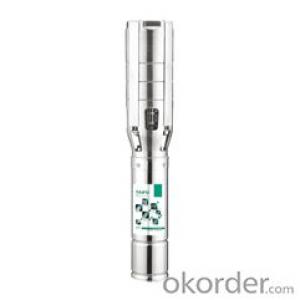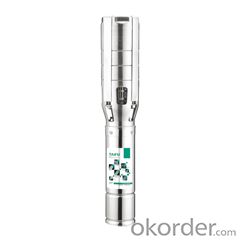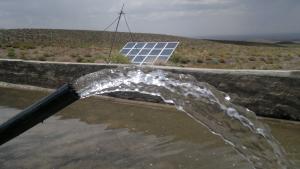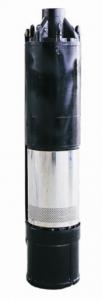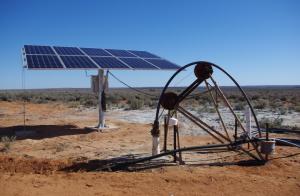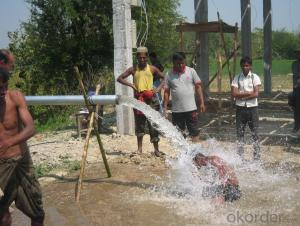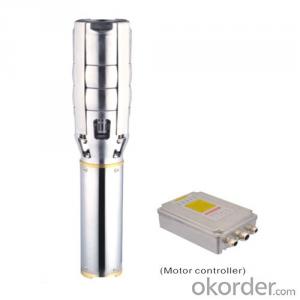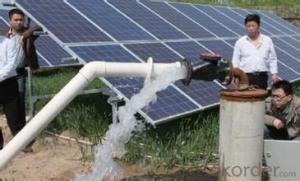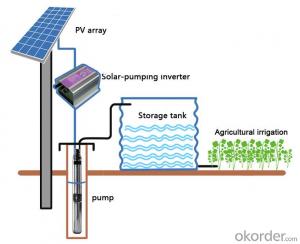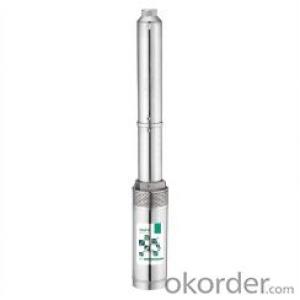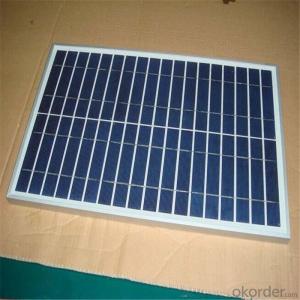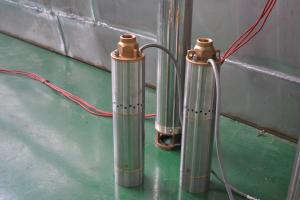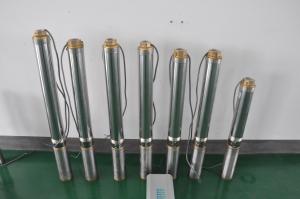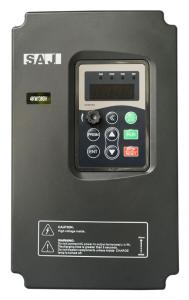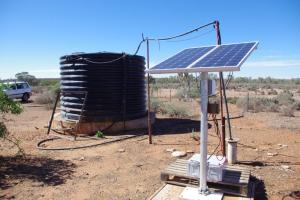Jintai Solar Pump 5tsc Stainless Steel CE Solar Panel
- Loading Port:
- Shanghai
- Payment Terms:
- TT OR LC
- Min Order Qty:
- 50 pc
- Supply Capability:
- 100000 pc/month
OKorder Service Pledge
OKorder Financial Service
You Might Also Like
1.APPLICATION AREA:This project products are mainly used in dry region for irrigation of agriculture, It can be used for drinking water and
living water. The living condition could be much improved. It also can be used for fountains.2.MATERIAL OF PARTS:Outlet: stainless steel
Pump body: stainless steel
Motor body: stainless steel
Bearing: C&U
3.ADVANCED TECHNOLOGY:1.Application innovation
Compared with the traditional alternating current machine, the efficiency is improved 25% by the permanent magnetism, direct current, brushless, non-sensor motor.
2.Technics innovation
Adopt double plastic package for rotor and stator, motor insulation≥300MΩ, the motor security was much improved.
3.Structure innovation
Oil filling, convenient installation and environmental protection4.HIGHLIGHTSa.Energy-saving and environment-protected green products
b.High technique products adopting MPPT and DSP chip technique.
c.100% copper wire, cold-rolled silicon steel sheet
d.CE certificate
e.Advanced three phase brushless DC motor
f.Stainless steel 316 screws
g.3 years warranty5.PRINCIPLE OF OPERATION:Solar panel collects sunlight→DC electricity energy → solar controller(rectification,stabilization,amplification,filtering)→available DC electricity→(charge the batteries)→pumping water6.ADVANTAGES OF SOLAR PUMP SYSTEM:A.It is easier and more widely used than any other dynamoelectric driven pumps.
B.It is more economical and more environmentally friendly.7.MODEL SELECTION:a.The power of solar panel = power of pump ×1.3
The voltage of solar panel = the voltage of pump
The controller should be matched
b.Select the batteries according to the following formulas:
The use hour of battery =
The battery capacity ÷(the machine power÷the battery voltage)×0.6 For example,the machine power is 200W, the battery
capacity is 100AH,the voltage is 12V,and the battery is fully charged,then the use hour is:100÷(200÷12)×0.6=3.6hours
c.The battery capacity=
the use hour ÷0.6×(the machine power÷the battery voltage) For example,the machine power is 200W,the battery voltage
is 12V,and the battery need to be used for 3.6hours,then the battery capacity is:3.6÷0.6×(200÷12)=100AH


- Q: What is the lifespan of a solar pump's solar panels?
- The lifespan of a solar pump's solar panels can vary depending on various factors such as the quality of the panels, maintenance, and environmental conditions. However, on average, solar panels used in solar pumps have a lifespan of around 25 to 30 years.
- Q: How does a solar pump handle water with high levels of heavy metals or radioactive materials?
- A solar pump, by itself, does not have a mechanism to handle water with high levels of heavy metals or radioactive materials. However, additional water treatment systems, such as filtration, chemical treatment, or reverse osmosis, can be integrated with the solar pump to address the presence of these contaminants and ensure the water is safe for use.
- Q: What is the role of controllers in a solar pump system?
- The role of controllers in a solar pump system is to regulate and optimize the operation of the system. They monitor and control the power input from the solar panels, manage the battery storage if present, and control the pump's speed and operation based on the water demand. Controllers also provide protection functions, such as overvoltage and overcurrent protection, ensuring the system operates efficiently and reliably.
- Q: Can a solar pump be used for water supply in residential communities or housing complexes?
- Certainly, water supply in residential communities or housing complexes can be facilitated by the use of a solar pump. Solar pumps present a viable alternative to traditional electric pumps, deriving their power from clean, renewable, and abundant solar energy. These pumps employ photovoltaic panels to convert sunlight into electricity, which then fuels the pump to extract water from sources like wells, boreholes, or reservoirs and distribute it to the desired destinations. The utilization of a solar pump for water supply in residential communities or housing complexes offers multiple advantages. Primarily, solar pumps prove to be cost-effective in the long term since they eliminate the need for fuel or electricity, thereby reducing energy expenses. Additionally, solar pumps require minimal maintenance, further contributing to cost savings. Moreover, solar pumps are environmentally friendly as they do not generate any greenhouse gas emissions or contribute to air pollution. They also aid in water conservation through the incorporation of sensors and controllers that optimize water usage and prevent wastage. Reliability and efficiency are hallmarks of solar pumps, enabling their operation even in remote areas with limited access to the electrical grid. These pumps ensure a consistent and uninterrupted water supply throughout the day, effectively meeting the needs of residential communities or housing complexes. In conclusion, solar pumps emerge as an exceptional choice for water supply in residential communities or housing complexes. They offer a plethora of benefits, including cost savings, environmental sustainability, and dependable operation. By harnessing the power of the sun, solar pumps provide a sustainable and efficient solution for satisfying the water demands of residential areas.
- Q: Can a solar pump be used in areas with limited access to water utilization?
- Yes, a solar pump can be used in areas with limited access to water utilization. Solar pumps are an efficient and sustainable solution for pumping water in remote locations where traditional electricity infrastructure is scarce or absent. They can be used to extract groundwater, irrigate farmland, provide drinking water, and support various water utilization needs in areas with limited access to water resources. The use of solar energy eliminates the need for grid electricity, making it a cost-effective and environmentally friendly option for pumping water in such areas.
- Q: Can a solar pump be used for irrigation in hilly areas?
- Yes, a solar pump can be used for irrigation in hilly areas. Solar pumps are powered by sunlight, eliminating the need for electricity or fuel. This makes them ideal for remote and hilly areas where access to traditional power sources may be limited. The solar panels can be strategically placed to maximize sun exposure, while the pump can be located at a suitable location to deliver water to the required irrigation areas. The use of solar pumps in hilly areas can promote sustainable and efficient irrigation practices while minimizing the environmental impact.
- Q: How does the maintenance cost of a solar pump system compare to a traditional electric pump?
- The maintenance cost of a solar pump system is generally lower compared to a traditional electric pump. This is primarily due to the fact that solar pumps have fewer moving parts and no complex electrical systems, which reduces the risk of mechanical failure and the need for extensive maintenance. Solar pumps are powered by solar panels, which have a long lifespan and require minimal maintenance. The main maintenance tasks for a solar pump system involve checking and cleaning the solar panels regularly to ensure optimal performance. Additionally, the pump itself may require occasional maintenance such as lubrication and inspection of connections. In contrast, traditional electric pumps require more regular maintenance due to the complexity of their electrical systems and moving parts. Electric pumps often have motors, wiring, and other components that can wear out over time and require maintenance or replacement. The electrical connections also need to be regularly inspected and maintained to prevent any potential issues. Furthermore, traditional electric pumps are typically connected to the grid, which means they are subject to fluctuations in electricity prices. This can result in higher operational costs compared to solar pumps, which rely on the sun's energy and do not incur any ongoing electricity expenses. Overall, while both solar pump systems and traditional electric pumps require maintenance, the maintenance cost of a solar pump system tends to be lower due to the simpler design, fewer moving parts, and reduced reliance on external sources of power.
- Q: How big of a solar panel is required for a solar pump?
- The size of a solar panel required for a solar pump depends on various factors such as the power output of the pump, its energy requirements, and the amount of sunlight available. It is recommended to consult with a solar expert or review the pump's specifications to determine the appropriate size of the solar panel needed for optimal performance.
- Q: Are solar pumps suitable for remote locations?
- Yes, solar pumps are highly suitable for remote locations. Remote locations often lack access to reliable electricity grids, making traditional pumps powered by electricity or fuel impractical. Solar pumps, on the other hand, can operate independently of the grid and rely on sunlight to generate power. This makes them an ideal solution for remote areas where there is an abundance of sunlight but limited access to electricity. Solar pumps are easy to install and require minimal maintenance compared to traditional pumps. They are usually self-contained systems that consist of solar panels, a pump, and a controller. These components are designed to be durable and withstand harsh weather conditions, making them suitable for remote and challenging environments. Furthermore, solar pumps can be used for various applications in remote locations, including agriculture, livestock watering, irrigation, and drinking water supply. They can be used to pump water from wells, boreholes, rivers, or other water sources, providing a sustainable and reliable water supply in areas where it may otherwise be difficult to obtain. Solar pumps also offer economic benefits in remote locations. They eliminate the need for costly fuel or electricity expenses, reducing operational costs and making them a cost-effective solution in the long run. Additionally, solar pumps can contribute to environmental sustainability by reducing reliance on fossil fuels and reducing carbon emissions. Overall, solar pumps are an excellent choice for remote locations due to their independence from the grid, easy installation and maintenance, versatility in applications, and economic and environmental benefits.
- Q: Can a solar pump be used for water supply in remote villages?
- Yes, a solar pump can be used for water supply in remote villages. Solar pumps are a sustainable and cost-effective solution for providing water in areas where there is no access to electricity. They rely on solar energy to power the pump, which means they can operate independently and reliably in remote locations. Additionally, solar pumps require minimal maintenance and have a long lifespan, making them suitable for sustainable water supply in remote villages.
Send your message to us
Jintai Solar Pump 5tsc Stainless Steel CE Solar Panel
- Loading Port:
- Shanghai
- Payment Terms:
- TT OR LC
- Min Order Qty:
- 50 pc
- Supply Capability:
- 100000 pc/month
OKorder Service Pledge
OKorder Financial Service
Similar products
Hot products
Hot Searches
Related keywords
